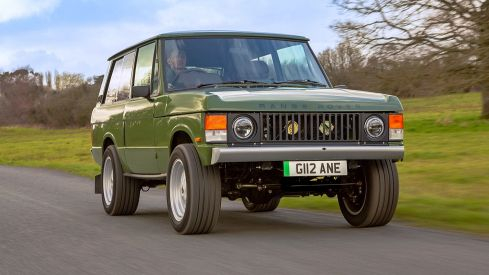That restomod They’re in style, no doubt about it. The British company Upside is dedicated to this and the latest incident is turning a classic Range Rover into an electric SUV with modern Tesla technology, spiced up with handcrafted interiors and finished with superlative exclusivity.
The upside took the first generation Range Rover as a base, removed the combustion engine and all associated components (the petrol version has a V8 engine and the diesel version has a 4 or 5 cylinder engine) and installed the electric motor, inverter, charger and battery with the Tesla module. It’s not as simple as it sounds, logically speaking, because the transformation goes much further.
Along with the conversion to an electric 4×4, every car that switches to Reverse experiences a complete restoration. That includes leaving the chassis bare, maintaining it (even more so in England, where humidity favors rust) and restoring its original, if not exceeding, paint splendor. The appearance of the original car has remained almost unchanged, although not exactly the same.
For example, the wheel has a larger diameter than it actually is, something that is visible to the naked eye. And the headlights with LED technology are also more modern, although visually they are less noticeable than the wheels.
Under the body hides the generating Tesla machine 450 horsepower and 600 Nm torque, which allows you to do 0-96 km/h in about 5 seconds. Much faster than the original car. The battery is made from repurposed Tesla modules, conveniently positioned to suit this vehicle. It has a capacity of 80 kWh and the maker says that it offers approx 320 kilometers of autonomy. Three driving modes are offered (Eco, Sport and Off-Road) and have regenerative braking.
It is equipped with a 6.6 kW alternating current on-board charger, while direct current fast charging supports up to 100 kW of power. With fast charging, you can recharge from 20% to 80% in “about 34 minutes”, according to the British company.
Change goes far beyond the engine. Converting a car like this means adding a lot of weight to the original, changing the weight distribution, etc., so you have to make modifications to the chassis. The car has new axles, improved in relation to the original, suspension with variable pitch dampers, stabilizer bars and a new brake system Alkon. Of course it still has permanent 4×4 traction, how could it be otherwise. It also has a new oil pump and a new self-locking differential.
Inside, the upholstery is covered in sustainably sourced leather in a mocha color matched with wood trim. A modern touch is provided by a multimedia system compatible with Apple CarPlay and Android Auto and a USB charging port. In addition, it is equipped with central locking, air conditioning and the soundproofing of the passenger compartment has been improved for greater comfort.
“Each car is carefully restored and customized to the client’s individual specifications,” they say from the company. This means that customization can be as large as a large client portfolio. After all, it won’t be cheap: the car costs 225,000 pounds, about 254,000 euros to current changes. This includes donor vehicles, which were purchased by Inverted. They offer a 12-month warranty and convert one of three versions of the model: two-door, four-door, and extended wheelbase (LSE).

“Entrepreneur. Internet fanatic. Certified zombie scholar. Friendly troublemaker. Bacon expert.”


:quality(70)/cloudfront-us-east-1.images.arcpublishing.com/elfinanciero/ZTJV57HVVJGODLL3YBCDPNWTAQ.jpg)




